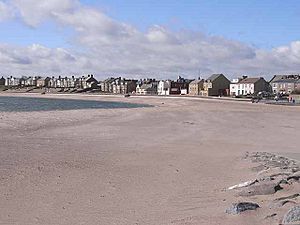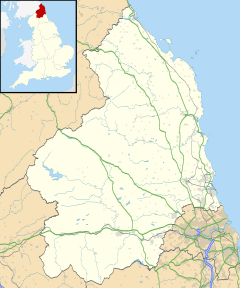Newbiggin-by-the-Sea facts for kids
Quick facts for kids Newbiggin-by-the-Sea |
|
|---|---|
 Newbiggin Bay |
|
| Population | 6,308 (2011) |
| OS grid reference | NZ308877 |
| Civil parish |
|
| Unitary authority |
|
| Ceremonial county | |
| Region | |
| Country | England |
| Sovereign state | United Kingdom |
| Post town | NEWBIGGIN-BY-THE-SEA |
| Postcode district | NE64 |
| Dialling code | 01670 |
| Police | Northumbria |
| Fire | Northumberland |
| Ambulance | North East |
| EU Parliament | North East England |
| UK Parliament |
|
Newbiggin-by-the-Sea is a lovely seaside town in Northumberland, England. It sits right on the North Sea coast. This town has a long history as a fishing port. It was also once important for shipping grain.
Newbiggin became a popular beach resort way back in 1828. Today, it's still a fun place to visit. You can see cool landmarks like the Couple sculpture by Sean Henry. There's also a very old church from the 13th century.
Contents
What's in a Name?
The name Newbiggin comes from old English words. Nīwe means "new" and bigging means "building" or "house".
This name might refer to a new part of an older settlement. That older place was called Woodhorn. Over time, the town's name has been spelled in different ways. Some old spellings include Newbiggen and Newbigging.
A Look Back at Newbiggin's Past
How Newbiggin Grew
For many centuries, the local church was just a small chapel. It had a tower with a spire. This spire was used as a beacon to guide ships.
In the 1300s, Newbiggin was a very important port. It helped King Edward III during his fights against the Scots. During the Middle Ages, Newbiggin was a major port for shipping grain. It was the third most important port for grain. Only London and Hull were bigger.
King Henry III even gave Newbiggin a special permission. This allowed the town to hold a weekly market every Monday. It also allowed an annual fair. In 1337, Newbiggin was important enough to send its own representatives. These representatives, called bailiffs, went to a special meeting. Important noblemen like the Bishop of Lincoln and the Earl of Warwick held this meeting.
Newbiggin from 1800 to Today
In 1805, a big storm hit Newbiggin. Two boats and nineteen men were lost at sea. People in the Newcastle area raised £1,700 to help the families.
By 1828, Newbiggin was already a popular beach resort. It had places for visitors to stay and enjoy themselves. The town had five pubs, some with special bathing areas. There were also shops and lodging houses. The beach was about a mile long and great for swimming.
By 1848, Newbiggin was a well-known summer resort. Many guesthouses opened up. The bay was a good place for small boats to anchor. However, it was mostly used by fishing boats. Most people in Newbiggin worked in fishing. They caught fish like pilchard, herring, cod, and haddock. These fish were mostly sold in Newcastle. They also caught salmon, trout, lobsters, and crabs.
How Newbiggin is Governed
Newbiggin-by-the-Sea has its own local government. It is called a town council.
In 1974, Newbiggin became part of the Wansbeck local government area. This changed in 2009. Now, the Northumberland County Council handles most local services.
Newbiggin-by-the-Sea is part of the Blyth and Ashington area for national elections. This area chooses a Member of Parliament (MP) to represent them in Westminster. Currently, Ian Lavery MP represents this area.
The old Wansbeck local government area and the current Parliamentary area are named after the River Wansbeck. This river flows into the North Sea near Newbiggin.
Newbiggin's Economy
Fishing has always been a big part of Newbiggin's life. Later, many people also worked in coal mining. By the Victorian era, Newbiggin was a favorite seaside town in Northumberland. Hundreds of visitors came every summer.
In 1869, there were 142 cobles in Newbiggin-by-the-Sea. Cobles are a special type of fishing boat.
Newbiggin Colliery was a coal mine that opened in 1908. It closed in 1967. At its busiest in 1940, about 1,400 men worked there. The old Newbiggin Colliery Band is now the Jayess Newbiggin Brass Band. It's named after James Shepherd, a famous cornet player.
Today, there are 89 active companies based in Newbiggin. This shows the town has a varied economy.
Famous Places and Sights
In 1868, Newbiggin was where the first telegraph cable from Scandinavia ended. This cable came all the way from Jutland, Denmark.
Today, you can visit the 13th-century parish church. There's also the Newbiggin Maritime Centre. This new center cost £3 million to build. It replaced the old heritage center.
The lifeboat station opened in 1851. This happened after a terrible fishing accident. Ten Newbiggin fishermen lost their lives in a storm. It is the oldest working boathouse in the British Isles. Newbiggin has had 13 different lifeboats over the years. Today, it uses an Atlantic 85 lifeboat. The brave crews have received 16 awards for their courage.
Newbiggin's beach was losing sand quickly. So, a £10 million project helped rebuild it. They brought 500,000 tonnes of sand from Skegness. A special ship called the Oranje delivered the sand. It was pumped onto the beach through a large pipe. A new offshore breakwater was also built. This helps protect the beach from waves.
A brass statue by artist Sean Henry is also in the bay. It is called Couple.
Newbiggin-by-the-Sea has the longest promenade in Northumberland. A promenade is a long walkway along the coast. In spring and autumn, many people come here. They watch seabirds migrating across the North Sea.
Places of Worship
The Parish Church of St Bartholomew is from the 13th century. It stands by the North Sea at Church Point. Inside, you can see many old gravestones from the Middle Ages. Eight complete stone grave covers are set into the walls. The church's chancel, arcades, and west tower are all from the 13th century. The spire was added in the 14th century.
Woodhorn Church used to be the main church for the area. But in 1973, it was no longer used. So, St Bartholomew's became the main church.
The Salvation Army has been in Newbiggin since 1902. Their main building for worship opened in 1939. They also have a community hall. The Salvation Army band is a fond memory for many who grew up in Newbiggin. In the 1960s, the band would play on the Quay wall every Sunday. In 1991, the Newbiggin-by-the-Sea Salvation Army choir recorded songs for BBC Radio.
St Mark's Church was built in 1868. It was once a busy Presbyterian church. Later, it became a United Reformed church. St Mark's is now closed for worship.
St Andrew's Methodist Chapel was built in 1876. In 2010, the United Reformed and Methodist churches in Newbiggin joined together. They now meet at St Andrew's. It is called St Andrew's and St Mark's (Methodist/United Reformed) Church.
Before St Andrew's was built, Methodists met in the Wesleyan Chapel. This chapel was built in 1844. In the early 1900s, the Salvation Army used this building.
The Apostolic Church came to Newbiggin in 1936. They first rented a room above a shop. Later, they bought a building on Gibson Street. This building closed in 2010. It is now a boxing gym. The Apostolic Church no longer has a church in Newbiggin.
St Mary's Roman Catholic Church is a small building on Front Street. It is part of the Parish of St Aidan's in Ashington.
Summer Fun and Music
Until 2004, Newbiggin had a street fair. Thousands of people came every year. The fair stretched along Front Street and the seafront. The lifeboat house became a music venue. A stage was set up, and the lifeboat house served food. Famous people like Slade and Leo Sayer performed.
Since 2010, the annual Old Ship Music Festival has tried to bring back a summer event. It invites bands from the area and around the world to play. Local comedians also perform. The festival raises money for charity. In 2010, it raised £700 for Help for Heroes. In 2011, it raised £1,100 for the Sir Bobby Robson Foundation.
Famous People from Newbiggin
- John Braine worked at the library in Newbiggin from 1954 to 1956. During this time, he wrote his very popular novel, Room at the Top.
- James Shepherd (1936–2023) was born in Newbiggin. He became a famous cornet player. He was the main cornet player for the Black Dyke Band.



